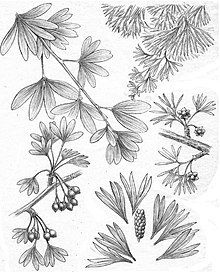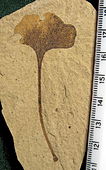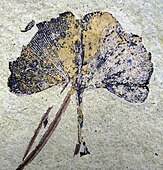Ginkgoales
| Ginkgoales Temporal range:
| |
|---|---|

| |
| Leaves and seeds ofGinkgo yimaensis(left)Yimaia recurva(top right) andKarkenia henanensis(bottom right) | |
| Scientific classification | |
| Kingdom: | Plantae |
| Clade: | Tracheophytes |
| Clade: | Gymnospermae |
| Division: | Ginkgophyta |
| Class: | Ginkgoopsida |
| Order: | Ginkgoales Gorozhankin, 1904 |
| Families | |
| |
Ginkgoalesare agymnospermordercontaining only oneextantspecies:Ginkgo biloba,the ginkgo tree.[1]The order has a long fossil record extending back to theEarly Permianaround 300 million years ago from fossils found worldwide.
Evolution[edit]
Ginkgophyta andCycadophytahave a very ancient divergence dating to the earlyCarboniferous.[2]The earliest representative of the group in the fossil record is probablyTrichopitysfrom theAsselian(299-293 million years ago) of France. The earliest representatives ofGinkgo,represented by reproductive organs similar to the living species, first appear in the Middle Jurassic, alongside other, related forms such asYimaiaandKarkenia,which have differently arranged reproductive structures and seeds associated withGinkgo-like leaves.[3][4]The diversity of Ginkgoales declined during the Late Cretaceous and Cenozoic, coincident with the rise of flowering plants, with all Ginkgophytes aside fromGinkgobeing extinct by the end of the Cretaceous.[5][4]The only remaining Ginkgophyte wasGinkgo adiantoides– a polymorphic species.[6]ModernGinkgotrees are native to China.[5]
Reproduction[edit]
Ginkgotrees produce ovulate and pollen-bearing structures. These structures aredioecious,in that male and female structures come from differentGinkgoplants.[5]The pollen organs are very similar to angiospermouscatkins.They come from theaxilsof the bud scales, and the leaves from theGinkgotree spur shoots. Pollen is contained in sacs of two to four at the tips of sporophylls on the strobiloid. Ovules ofGinkgotrees come from stalks from leaf axils on the short shoots, each containing two ovules. The ovule is fertilized by the flagellated male gametes, which can move about freely. This fertilization process begins on the tree itself in the spring. The swollen fruit-likeovules,about 2–3 cm in diameter, fall from the tree in the fall, and fertilization continues into the winter/spring.[4][6]This ovule contains a single large seed, similar to that of acycad.[4]
Morphology[edit]
Ginkgophyte wood[edit]
Fossils that appearGinkgo-like are filed under amorphogenuscalledGinkgoxylon, Ginkgomyeloxylon,orProtoginkgoxylon.Fossilized ginkgophyte wood is not commonly found in the record, possibly because it degrades easily, and possibly because it is difficult to tell apart from the much more pervasiveconifersamples.[4]Like conifer wood, it has secondary thin-walled xylem and a primary vascular system composed of eustele and bifacial vascularcambium.The tracheids in the secondaryxylemrays have pitting that occurs only on the walls and is circularly bordered.[5]

Ginkgophyte foliage[edit]
Ginkgophytefoliagehas stayed largely consistent since theMesozoic.Its historically wide territory makes it an important leaf morphology, and its uniquestomataand isotopic profile give it a key role in recreations of the Mesozoic andCenozoic.Leaf fossils that resemble the Ginkgophytes are known asGinkgoites.There are similar, now extinct, morphogens, such asSphenobaiera,which describes fan-shaped, deeply divided leaves without clearpetioles.
The distinctive shape of the modernGinkgo bilobagives the impression of a very narrow leaf morphology, but the group is varied and diverse. The genusGinkgoby itself contains a range of morphologies.Ginkgo digitata,from theJurassic,has long, wedge-shapedlaminaewith the intercostal regions covered in stomata and resin bodies, whileG. pluripartitahas at most 2 cm-long leaves and is intercostallyhypostomatic.[4]
Fossil gallery[edit]
-
A 6.7 cm tallGinkgo bilobaleaf, with insect herbivory.Klondike Mountain Formation,Republic, Ferry County, Washington, USA,Eocene,Ypresian,49 million years old
-
A 70 mm-wideGinkgo bilobaleaf. Klondike Mountain Formation, Republic, Ferry County, Washington, USA, Eocene, Ypresian, 49 million years old
-
Ginkgo bilobaEocenefossil leaf from the Tranquille Shale of MacAbee, British Columbia, Canada
-
Fossil ofGinkgo huttoni.Photo taken at Naturalis Museum inLeiden,The Netherlands.
-
Fossil ofGinkgoiteshuttoni
References[edit]
- ^Christenhusz, M.J.M., J.L. Reveal, A.Farjon, M.F. Gardner, R.R. Mill, and M.W. Chase (2011). A new classification and linear sequence of extant gymnosperms.Phytotaxa19:55–70.http://www.mapress.com/phytotaxa/content/2011/f/pt00019p070.pdf
- ^Stull, Gregory W.; Qu, Xiao-Jian; Parins-Fukuchi, Caroline; Yang, Ying-Ying; Yang, Jun-Bo; Yang, Zhi-Yun; Hu, Yi; Ma, Hong; Soltis, Pamela S.; Soltis, Douglas E.; Li, De-Zhu (19 July 2021)."Gene duplications and phylogenomic conflict underlie major pulses of phenotypic evolution in gymnosperms".Nature Plants.7(8): 1015–1025.doi:10.1038/s41477-021-00964-4.ISSN2055-0278.PMID34282286.S2CID236141481.
- ^Zhou, Zhi-Yan (March 2009)."An overview of fossil Ginkgoales".Palaeoworld.18(1): 1–22.doi:10.1016/j.palwor.2009.01.001.
- ^abcdefTaylor, Thomas N.; Taylor, Edith L.; Krings, Michael (29 December 2008).Paleobotany, Second Edition: The Biology and Evolution of Fossil Plants(2nd ed.). Academic Press.ISBN9780123739728.
- ^abcdBeck, Charles (2014)."Ginkgoales".Access Science.doi:10.1036/1097-8542.289700.Retrieved13 April2017.
- ^abJalalpour, Julie; Malkin, Matt; Poon, Peter; Rehrmann, Liz; Yu, Jerry (1997)."Introduction to the Ginkgoales".www.ucmp.berkeley.edu.Retrieved20 April2017.





